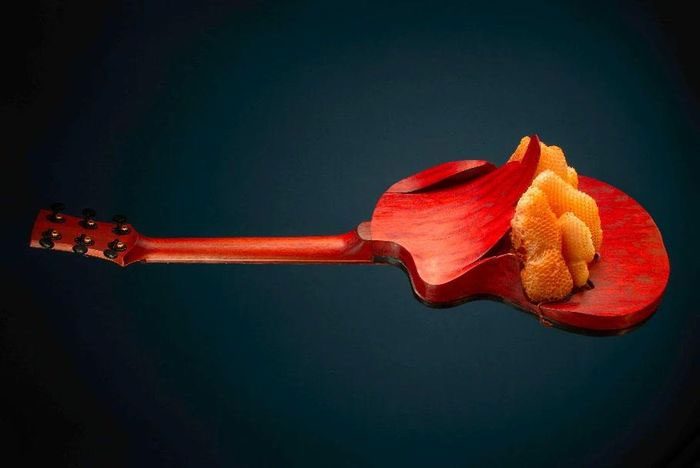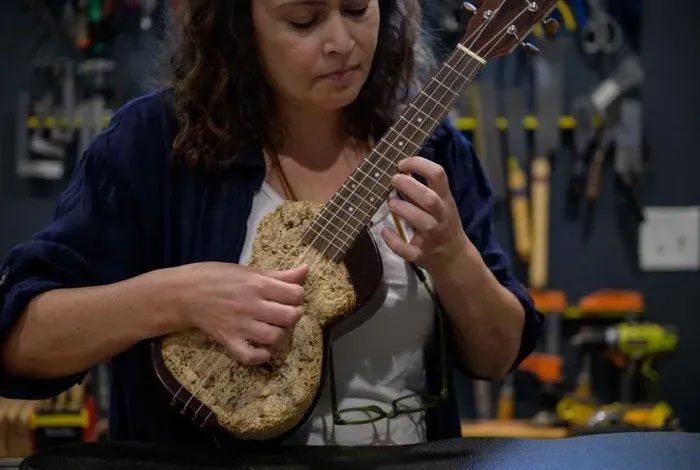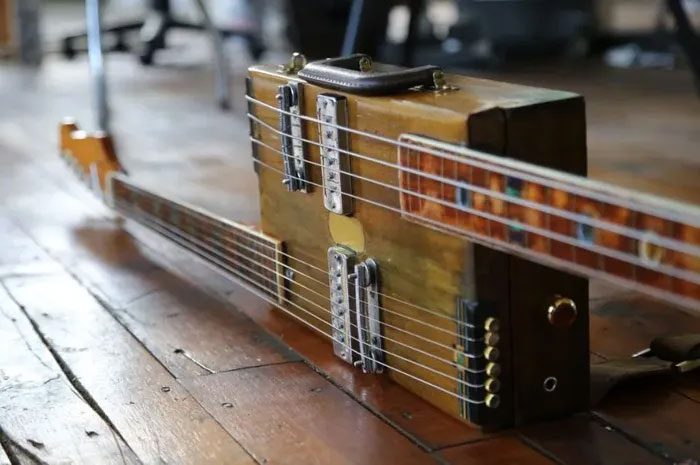When thinking of a guitar, you might envision a simple acoustic wooden guitar made from maple that countless singers and musicians have played over the years, or you might picture electric guitars favored by rockers.
Although the image of traditional guitars has left a mark in our minds, there are new instruments that are attracting attention, especially when they are made from unique materials.

Rachel Rosenkrantz has “integrated” honeycomb into this guitar. (Source: CNN)
Young artist Rachel Rosenkrantz, a guitar-making expert, shared with CNN about her success in using bio-based materials to craft these instruments.
Special Collection
From ukuleles made from mushrooms, guitars made from honeycomb to banjos made from kombucha leather, she has created an intriguing collection of instruments made from biodegradable materials.
The story began in the 2000s when Rosenkrantz was a 21-year-old student living in Paris, France, torn between becoming a musician or a visual artist.
Her work in guitar making allowed Rosenkrantz to combine both of her passions. However, local luthiers told her that she started this work a bit late, despite her young age, so she initially focused on design.
Ten years later, Rosenkrantz moved to Rhode Island, USA, and began to pursue her musical passion again. She started experimenting with guitar making and has been producing instruments for the last 13 years. “At 42, I am truly living my dream. It’s never too late to start a passion,” she told CNN.
After researching the impact of guitar making on certain tree species, Rosenkrantz decided to use bio-based materials for production.
“Although we (guitar makers) do not account for a large percentage of wood consumption, we still contribute to environmental harm,” Rosenkrantz noted. “Guitar manufacturers are often very careful about the source of the wood they use.”
In the USA alone, about 2.6 million guitars are produced each year. Unlike the construction and furniture industries, which prefer fast-growing timber, guitar production often requires rare and aged woods such as mahogany, ebony, and rosewood.
These trees are typically cut perpendicular to their growth rings to produce better sound.
However, to fully construct the “body” of each guitar, larger pieces of wood are needed, which means cutting down ancient trees. Importantly, these materials are not always readily available.

Rachel Rosenkrantz playing an ukulele made from mushroom fibers. (Source: CNN)
Brazilian rosewood was once highly sought after for making guitars, but this species is only found in the coastal forests of South America.
Rosewood is also facing serious threats from illegal logging for agricultural and other purposes. Since 1992, the use of this wood has been banned by the Convention on International Trade in Endangered Species of Wild Fauna and Flora (CITES).
Similarly, spruce wood was widely used for crafting acoustic guitars. However, it can only be harvested from the Tongass National Forest in Alaska, USA—where overexploitation is causing some guitar manufacturers to seek more sustainable materials.
Inspired by Sustainable Materials
At the start of her guitar production work, Rosenkrantz questioned whether she could create instruments without using wood and plastic.
From her design experience, she noticed that bio-based materials were being used in everything from cars to sneakers. She began experimenting with replacing plastic with fish leather—sourced from a supplier in Brazil.
“Fish leather is more durable and flexible than plastic. It can be used for scratch-resistant patches on the guitar face, making it a great match with wood,” she explained.
Mycelium, a root-like structure made of thin threads produced by fungi, is another material that caught Rosenkrantz’s attention. She discovered that this material could replace polystyrene thermoplastic.
“The sound conduction ability of polystyrene is incredible because it is filled with air. So, what if we used a natural material with similar properties?” she posed.

A “creation” by Rachel Rosenkrantz. (Source: CNN)
Rosenkrantz sourced mushroom fibers from a supplier in the suburbs of New York. She mentioned that these fibers can be cultivated into any shape, eliminating the need for wasteful “cutting” during the guitar production process.
Her electric guitar “Mycocaster” is made from mushroom fibers and paper, reinforced with dry materials like corn husks to enhance the body’s sturdiness.
“Novel” Sounds
Rosenkrantz’s creations have a slightly different sound compared to traditional guitars. For instance, “Mycocaster” produces a sharp and “muffled” sound.
“I didn’t know the guitar would produce such tones,” she said. However, she believes these “quirky” instruments can bring new and unique music. “If we want to create new sounds, we can start with materials that nobody has used before.”
With “Mycocaster,” Rosenkrantz also “integrated” some pickups and microphones into the mushroom fiber body, allowing players to adjust the “mushroom sound” to their liking.
Some of her customers have unique requests. A film score composer asked for “something that could produce sounds similar to various instruments.” Thus, Rosenkrantz crafted a nine-string electric guitar with “baritone” sound made from leftover fish leather.
However, the price of these custom guitars is not cheap. “Mycocaster” currently costs $4,000, and Rosenkrantz has three orders for this model.
Rosenkrantz expressed her desire to reduce production costs, but “it will require support from a larger manufacturer to achieve that.”
“I want the guitar to cost around $50 so that every child can afford one. Perhaps the mushroom-shaped guitar will be a way for me to realize my dream,” Rosenkrantz said.
“I believe in the potential of this work. What is considered strange today may not be so tomorrow,” she added.


















































